Adapt or die.
The pace of change in today’s business landscape is dizzying, and there aren’t many industries that move as rapidly as marketing.
Today, 63% of CMOs and marketing managers think traditional methods of brand advertising and positioning are either losing their effectiveness or broken.
This forces marketing teams to compensate by experimenting with new channels and ideas on-the-fly, using tools like TrueNorth to identify and prioritise their highest-performing campaigns.
Without the luxury of time, many marketing teams are adopting Agile Marketing methodologies to become more flexible in our ever-changing business landscape.
What’s in This Guide?
If your company is exploring Agile Marketing, you’re in the right place. This guide has everything you need to begin implementing Agile today:
- What Is Agile Marketing?
- “Agile” vs “agile”
- 5 Reasons to Implement Agile Marketing
- The Traditional Waterfall Methodology
- Agile Marketing Frameworks & Terminology
- Agile Methodology vs Waterfall Methodology
- Scrumbum Terminology
- How to Implement Agile Marketing
- Is Agile Marketing Right for Your Team?
Stay loose as we explore what Agile can do for you.
What Is Agile Marketing?
Agile Marketing is a work management methodology that emphasises visibility, collaboration, adaptability, and continuous improvement. Agile teams value flexibility and responsiveness above all else and have passions for collaboration and experimentation.
Agile as a management framework didn’t originate with marketing. It began with software developers in the 1980s who were searching for a more agile project management methodology due to constantly changing requirements from their customers.
But as the business world has sped up, it’s become increasingly important for marketing teams to adopt similar Agile principles to shorten their project lifecycles and become more responsive and adaptive to the feedback they receive on campaigns.
Instead of spending three months planning a robust ad campaign for a new product launch, Agile teams spend three weeks creating a minimum viable product they can push live to gather immediate feedback on performance before executing an iterative cycle of improvement.
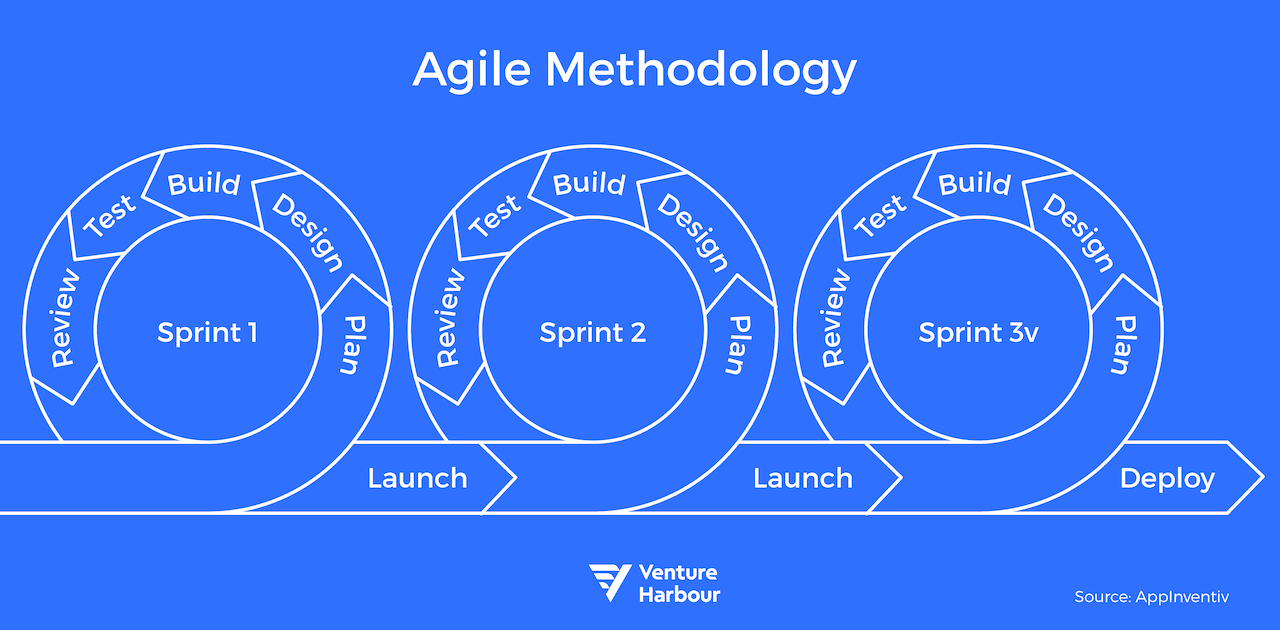
“Agile” vs “agile”
Agile marketing teams require agile marketers.
The first “Agile” is a proper noun that describes the entire Agile framework, which is a structured methodology with a set of principles and practices to help marketing teams achieve better results.
The second “agile” is an adjective that describes the individual members of the team, who are fluid and quick to respond to dynamic work environments.
Ideally, Agile teams are made of agile team members.
5 Reasons to Implement Agile Marketing
When compared to traditional project management frameworks, Agile Marketing is the easy winner. A survey conducted by CMG Partners asked CMOs about the results of adopting Agile:
- 93% said Agile has helped them improve their speed to market
- 93% said Agile helped them switch gears more quickly and effectively
- 87% said Agile has made their teams more productive
- 80% said Agile has led to an enhanced prioritisation of the things that matter
- 80% said Agile helped them deliver a better, more relevant end-product
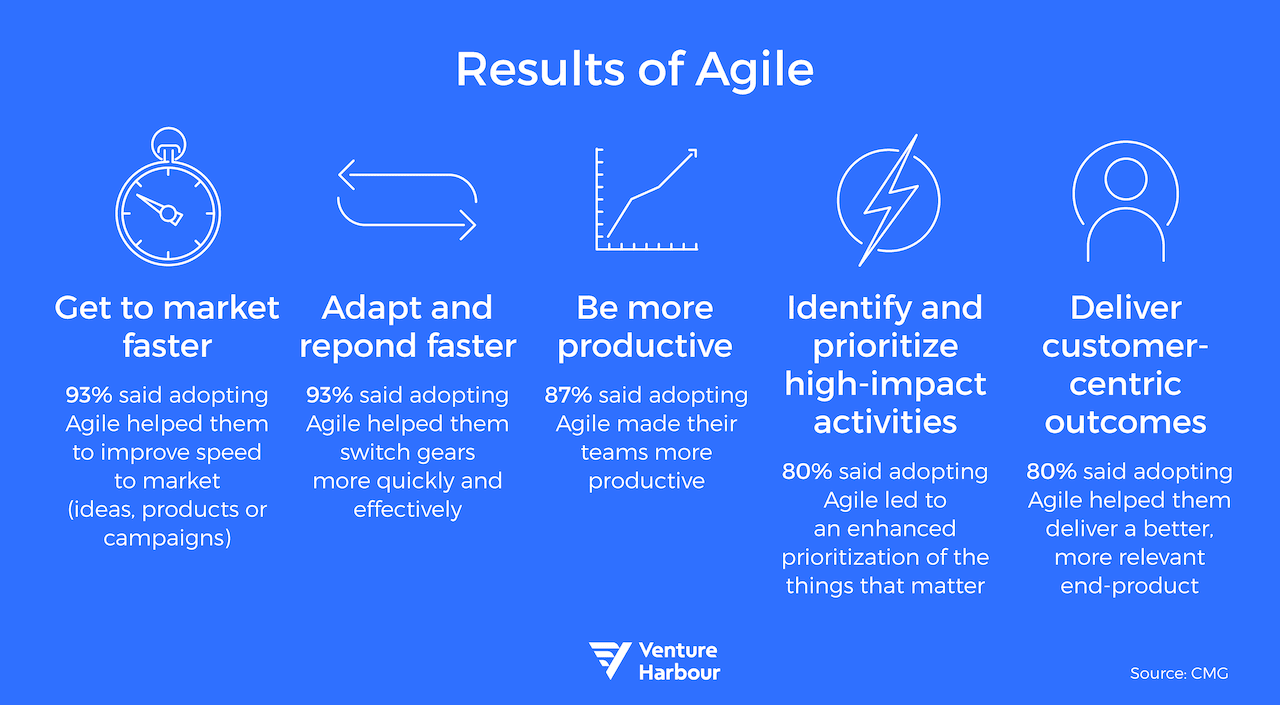
The Traditional Waterfall Methodology
The most common traditional marketing methodology is known as Waterfall. It’s characterised by breaking work into several sequential segments, which follow each other chronologically and rarely have much overlap. If you’ve ever planned a marketing campaign using a Gantt Chart, you’re familiar with the Waterfall methodology.
Waterfall has its place in many industries that value sequential, stepwise planning and execution. Construction is a fantastic example, as there’s a linear process of planning, permitting and execution to follow in a structured order.
However, marketing doesn’t flow as linearly as construction. Like software development, there’s an iterative feedback requirement that the Waterfall methodology struggles to satisfy.
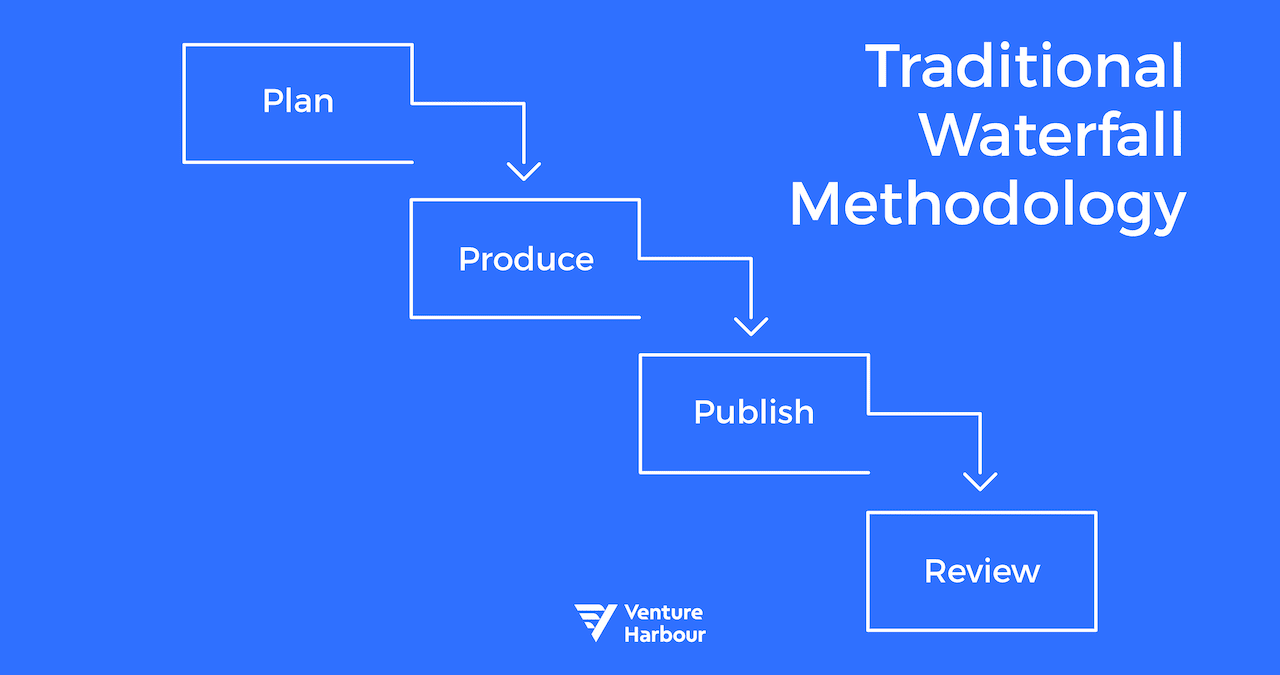
Agile Marketing Frameworks & Terminology
There are three primary Agile frameworks:
- Scrum: The original Agile methodology developed by 1980s software teams
- Kanban: A 1950s resource management framework developed by Toyota production teams
- Scrumban or Modified Scrum: A hybrid Scrum-Kanban framework that’s better suited to the needs of today’s marketing teams
To best discuss their differences, it’ll first help to clarify a few Agile terms:
- Backlog: The ever-growing list of work items to be completed
- Sprint: Derived from Scrum, a short period of intense work
- Story: A single work item
- Story Points: Estimates of the resources required to complete a story, generally measured in hours
- Storyboard: Derived from Kanban, a visual representation of all stories to be completed
- Swimlanes: Derived from Kanban, columns on the storyboard representing different phases of work (e.g., requested, in progress and completed)
Now back to those three Agile frameworks.
Scrum
Scrum is based on the idea that teams work best with short sprints of concentrated, prioritised work. These sprints last just 1-3 weeks, and all work is executed by a small team of just 3-7 team members led by a Scrum Master.
Scrum’s goal is to identify all stories (requested work items), prioritise each story, and choose which stories the team has the resources to complete with the goal of producing a minimum viable product by the end of the sprint. After the sprint, the team reviews actual versus expected results and reviews the sprint process to continuously improve their workflow for better productivity.
Kanban
Whereas Scrum uses an iterative cycle of short sprints to prioritise and complete stories, Kanban is continuously in execution. Kanban involves creating a central storyboard with swimlanes for stories in different stages; typically, requested, in progress and completed. New stories are added to the storyboard continuously, and the entire storyboard is in a constant state of review.
Scrumban or Modified Scrum
Scrumban, also known as Modified Scrum, is a hybrid of both Scrum and Kanban that borrows elements of each to suit the needs of today’s marketing teams.
It heavily leverages the Scrum framework with short sprints of focused work but also includes Kanban’s visual storyboard and status swimlanes while still respecting Waterfall’s sequential structure.
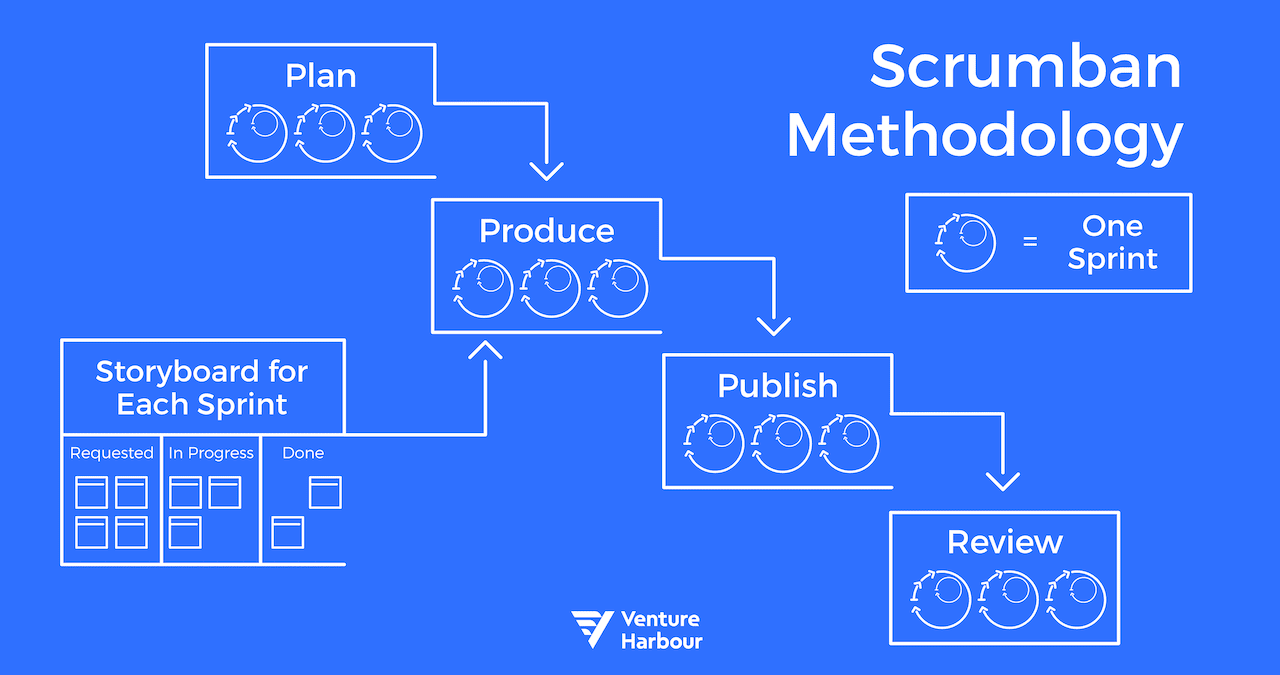
Ultimately, there’s no single “best” Agile Marketing Framework. It depends on several factors:
- Your company’s industry and the type of products or services you provide
- Your organisational culture and willingness to integrate Agile principles
- Your specific team members’ personalities, strengths and weaknesses
However, most marketing teams find Scrumban to be the best Agile Marketing framework for their teams.
Agile Methodology vs Waterfall Methodology
Waterfall methodology usually doesn’t work too well for marketing teams for two reasons:
- Ever-changing requirements
- Lengthy timelines
1. Ever-changing requirements
Software developers developed Scrum in the 1980s because they kept bringing versions of the completed project to clients only for clients to change what they wanted. Ever hear the phrase, “You don’t know what you don’t know”? That was a common problem, as clients didn’t realise all of the possible features until they started to see it come together.
The same happens with marketing campaigns. As work progresses from marketing plan development to execution to delivery, requirements frequently change. Waterfall isn’t well-suited to adjust with each change requiring you to go back to previously completed phases. This bogs down the process and makes teams feel like they’re spinning their wheels.
Agile Marketing frameworks like Scrumban are well-equipped to deal with changing requirements because sprints only last a few weeks at most. After each sprint, the Agile team reviews newly-requested stories, reprioritises the backlog and gets to work on the next 1-3 week sprint.
2. Lengthy timelines
Most marketing campaigns take 6-12 months (or longer) to roll out. That’s a considerable amount of time, which means the initial planning phase and the final delivery phase are separated by a large gap where your marketing team might as well be working in an underground bunker utterly unaware of the changing market conditions around them. By the time the final product is rolled out, one of two things is usually true:
- It’s no longer the best campaign given the new environment.
- It changed so much due to the aforementioned ever-changing requirements that it’s disconnected from the initial planning phase.
Because of those very obvious downsides, it’s no wonder CMOs love what Agile has done for their marketing teams.
Scrumban Terminology
Because Scrumban is the most common Agile Marketing methodology used, let’s define a few more terms used by Scrumban teams.
Key Scrum Roles
Scrumban leverages a small Agile team of 3-7 people, plus a couple of external stakeholders that connect the Agile team to the rest of the organisation.
The Scrum Master is the person who leads the Scrum. They’re responsible for cataloguing and filtering all requests that come to the Agile team, and they facilitate all Scrum meetings. The Scrum Master doesn’t have to be a boss, executive or anyone in a leadership role. Anyone on the Agile team can be the Scrum Master, and many high-performing Agile teams rotate Scrum Masters after each sprint to allow everyone to develop the skills required to succeed in the role. After all, Agile is all about flexibility.
Team Members are the remaining people who make up the Agile team. Including the Scrum Master, the Agile team should have between 3-7 people. If you have more, consider breaking up into two or more complementary Agile teams.
The Project Owner is the person who oversees the deliverables or outcome of the sprint. Usually, it’s an organisation leader who people on the Agile team already report to, but that isn’t always the case. In fact, sometimes there isn’t even a Project Owner.
The Requestor is anyone who requests work from an Agile team. They’re a stakeholder in the process and will be included in the Sprint Retrospective meeting.
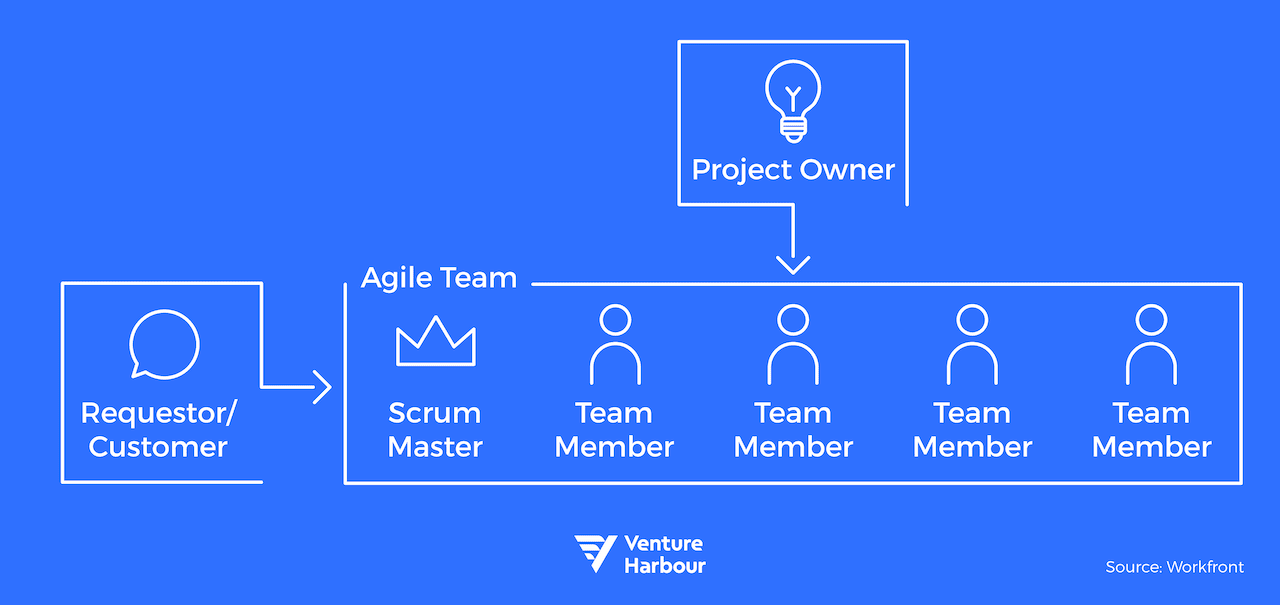
The 4 Types of Scrum Meetings
Speaking of meetings, there are four types of Scrum meetings common in Agile Marketing cycles.
The Sprint Planning Meeting is the major kickoff meeting that happens a few days before the scheduled sprint. This meeting is the longest of the entire process, often taking several hours, and is where all of the planning work is done for the full 1-3 week sprint.
- Identify all requests to form the backlog.
- Score and prioritise all stories in the backlog.
- Determine which stories the sprint will include.
- Distribute stories to Agile team members.
The Daily Scrum or Daily Standup occurs at the beginning of each day during the sprint and lasts just 10 minutes or less. During these meetings, each Agile team member quickly recaps what they accomplished yesterday, what they’ll accomplish today and any roadblocks they’re facing.
The Sprint Review is a short meeting, less than an hour, which takes place shortly after the completion of the sprint. This meeting includes the Agile team, the Project Owner and the Requestor to hand over deliverables and discuss progress achieved. The Sprint Review is outcome-oriented, and there are no PowerPoint presentations allowed!
The Sprint Retrospective is a longer meeting, generally 1-2 hours, and usually takes place after the Sprint Retrospective. Unlike the Sprint Review, the Sprint Retrospective includes only the 3-7 Agile team members and is process-oriented. The goal of the Sprint Retrospective is to compare the results of the sprint versus what was expected and discuss improvements that can be made to the process to achieve better results with future sprints.
How to Implement Agile Marketing
If you’re thinking about implementing an Agile Marketing framework for your company, there are a few things you’ll need to do before you hold your first Sprint Planning Meeting.
1. Get organisational buy-in
For most organisations using the traditional Waterfall methodology, Agile principles are a huge shock to the system and making the transition requires a lot of organisational change management. You must get buy-in at every level, including executives, potential Agile team members and future requestors.
If you’re a startup using Agile from the get-go, the buy-in process may be easier as you have a clean, blank slate to design your startup marketing strategy.
2. Form teams and map out your workflow
Once you have organisational buy-in, it’s time to put your Agile team together and map out your process, including a standardised request process. While most Agile Marketing workflows most closely resemble Scrumban, you can modify the process to suit both your organisation’s needs and the strengths of your personnel.
As you execute your first few sprints and review the process during your Sprint Retrospectives, you can continuously modify the workflow for better efficiency.
3. Plan your first sprint
Now it’s time for your first Sprint Planning Meeting. Typically, this is the longest meeting of the entire lifecycle, but it’ll probably be extra long for the first few times through the process. Don’t worry if it’s disjointed or inefficient. It’s a learning experience for everyone, so make it fun by ordering food or making a party out of it (if that’s part of your organisational culture).
One of the hardest parts of your first Spring Planning Meeting is understanding how to prioritise and select stories to be included in the sprint. Let’s look a little closer at each.
Prioritising stories
The first step in prioritising stories is identifying them all, so begin by having every team member write down their open work items on Post-It notes, including any work from external requestors. Aggregate your backlog of Post-It notes on your storyboard and remove any redundant items. Now go through all of the Post-Its and organise them with the most pressing items on top and the least pressing on the bottom.
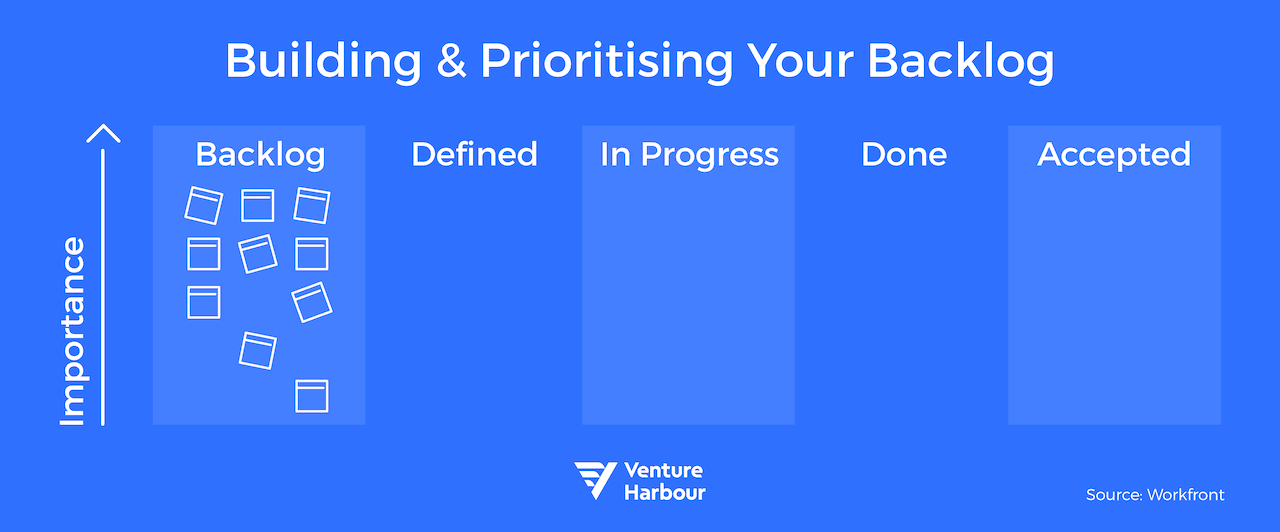
Estimating capacity and adding stories to the sprint
Once you have your backlog prioritised, it’s time to figure out where to draw the line. Any items above the line are included in the sprint. Any items below the line aren’t.
The first step at this stage is determining how much capacity your team has. Generally, this is measured in hours where each member of your team takes their standard work week and subtracts time they’re allocated to other tasks, such as meetings or answering emails.
Let’s say one of your team members, Peter, works a 40-hour week. He has a one-hour meeting every day during the week and answers emails for one hour at the end of each day. Peter’s capacity looks like this:
- Total Work Time: 40 hours
- Meetings: 1 hour per day x 5 days = 5 hours
- Answering Emails: 1 hour per day x 5 days = 5 hours
- Sprint Capacity: 40 hours – 5 hours (meetings) – 5 hours (answering emails) = 30 hours
If your sprint is three weeks long, Peter has 90 hours of capacity during the sprint (30 hours per week x 3 weeks).
Repeat this process for every team member until you know how much total sprint capacity your team has.
Next, you need to identify how many hours each story will take to complete. In the definitions section above, we called these story points. As a rule of thumb, most stories should take less than a single day to complete, so if you have any stories that’ll take more than a day, consider breaking them into multiple smaller stories.
With all of your stories assigned story points, work from the top of your prioritised backlog to the bottom until your team runs out of capacity to complete any remaining work. That’s where you draw the line for the sprint.
4. Execute the sprint
With your first Sprint Planning Meeting complete, all that’s left is to execute the sprint! Use the 10-minute Daily Scrum to divide up the open stories with team members voluntarily choosing which stories they’ll own and physically moving the story to the appropriate swimlane on your storyboard. Repeat this process every day.
5. Review the sprint
Once your first sprint is over, it’s time to review the results with your pair of post-sprint meetings: the results-oriented Sprint Review meeting with stakeholders and the process-oriented Sprint Retrospective with your Agile team.
What did you learn about your workflow? How well did your team do prioritising stories and assigning story points? Were you Daily Scrums efficient?
Make workflow changes as needed and incorporate those changes into your next cycle.
Is Agile Marketing Right for Your Team?
Agile Marketing is a powerful framework embraced by CMOs and other organisational leaders around the world, but that doesn’t mean it’s right for every team. In fact, implementing Agile Marketing can be disastrous for industries, organisations, or individuals who aren’t a good fit.
While Agile Marketing is the right choice more often than not, here are two instances where Agile may not work.
1. You work in a strictly-regulated field like healthcare or finance
Though Agile can work for healthcare and finance organisations, these industries are also heavily-regulated and have defined requirements for many of their outputs.
2. Your team doesn’t see the value of Agile
Buy-in is required for Agile to work. If your executives don’t see its benefit, your efforts may be doomed from the start. Similarly, Agile requires a significant culture change among team members, requestors and other stakeholders. If you don’t have organisational buy-in, it may be worth hiring an Agile consultant or coach, who can help show the benefits of Agile to increase buy-in among key stakeholders.
Conclusion
More than ever, it’s crucial for marketing teams to remain agile and flexible in their constant search for value in a dynamic, rapidly-changing business landscape.
Increasingly, Agile Marketing is the answer. It’s a game-changing framework with the potential to maximise your team’s output and productivity, making you more responsive to industry trends while providing better results to your clients and internal stakeholders.
But to truly make the most of your newfound productivity, you need tools that are capable of keeping up with your new Agile processes.
We’re currently in the process of building TrueNorth, a marketing management system that helps marketing teams create adaptable plans, prioritise campaigns, and rally their teams around the marketing plan.
If you’re interested in joining our beta, you can join here. As a Venture Harbour reader, you’ll be jumped to the front of the beta queue.




